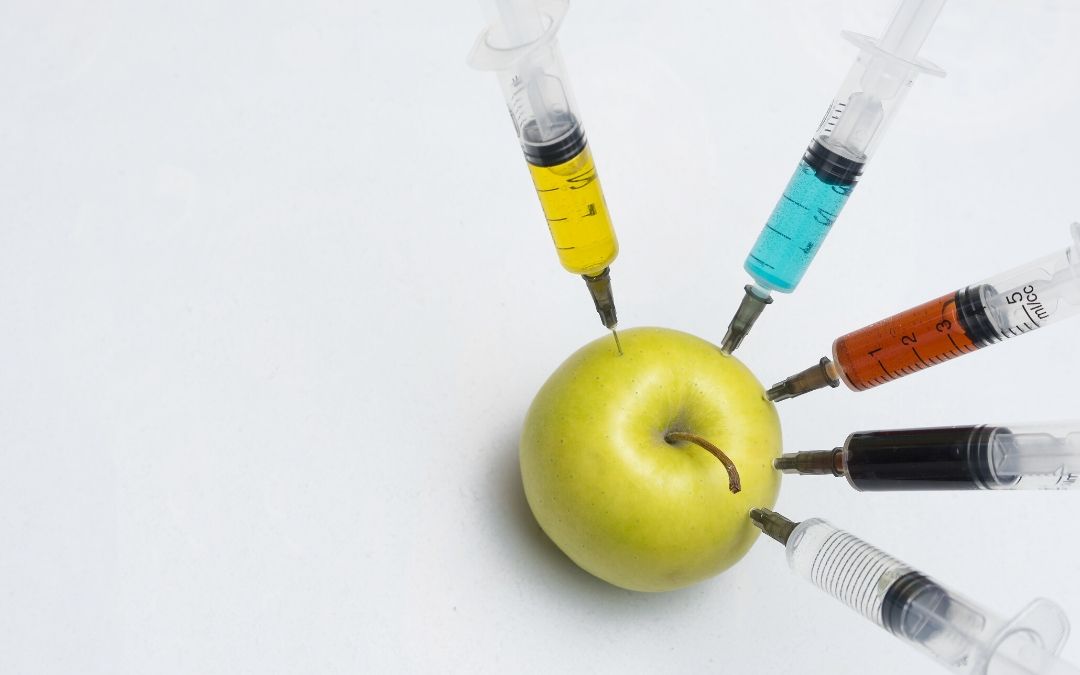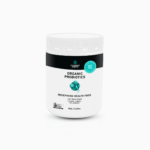Synthetic biology, bioengineering, bio-design and biotechnology are just some of the names that are being used to describe the production of a new wave of ingredients in our food supply, medications and cosmetics.
What does it all mean?
In short, this relatively new science is using microbes (bacteria, fungi, mould and viruses) to produce food additives, cosmetic ingredients and pharmaceuticals. The microbes are, for the most part but not always, genetically modified (GM) to create a substance that is needed in vast quantities. This is because the natural form of these substances may be too expensive, unfeasible, cumbersome, too slow, have a poor yield or are not profitable.
Citric acid was once a by-product of citrus fruit but now it is made by a genetically modified mould.
Xanthan gum came from a black mould found on broccoli and cauliflower. Now it’s made by a genetically modified mould grown on a substrate.
Ascorbic acid comes from wheat converted to glucose and then by a GM microbe into ascorbic acid (not vitamin C).
Natural flavours and colours may come from a substance grown by a GM microbe.
Listshield. You won’t see this listed in your ingredients because it’s a process not an ingredient. But it’s a mix of viruses called novel bacteriophages (altered by the hand of man) that is sprayed on meat and chicken to prevent listeria. It was approved by the FDA in 2007. It can also be used on apples, lettuce, honeydew melons, fresh cut produce, smoked salmon and frozen foods.
Let’s take a deeper dive into a couple of other products…
Synthetic Stevia
Recently a new multi-million dollar facility was opened by Cargill (a large food producer) to make synthetic biology GM 2.0 Stevia, commercially known as EverSweet. So, when you see Stevia on your ingredient list, it may possibly be bio-engineered – not from the real plant grown in soil with all the other components that make it a health-giving herb.
Stevia is in a few of my products at Changing Habits (Supreme Green Blend and Peak Performance) but it is the whole plant, not an extract (steviol glycoside), nor made with synthetic biology EverSweet.
Stevia in its whole form is sometimes called sweet leaf, because the plant has sweet leaves. It is highly nutritious, containing between 34-39% amino acids, it’s an excellent source of calcium, potassium, magnesium, phosphorus and iron as well as vitamin A and C, and it is used for detoxifying the body. It can be used as a poultice for fevers and ulcers. Stevia glycosides, mainly stevioside and rebaudioside, are the active compounds responsible for the beautiful sweetness. These compounds are not found alone in nature; they are in the mix of macro and micro nutrients found in the stevia plant.
Cargill is not the only company that synthetically makes stevia glycosides. Another company is Conagen, based out of Boston. It is an ingredient innovation company that uses modern synthetic biology tools for biological production of food additives, pharmaceuticals and cosmetic ingredients.
Conagen optimises metabolic pathways to produce rebaudioside (Reb M), the predominant sweet agent in stevia. By starting with the natural enzymatic pathway that converts stevioside to rebaudioside, Conagen uses a ‘gene discovery’ (a nice way of saying genetically modified) process to identify and optimise several other pathways to rebaudioside. This is by using gene manipulation. The resulting commercial product, BESTEVIA®, a Reb M stevia leaf sweetener, can be found in multiple food products in local grocery stores, including yogurt and carbonated beverages.
According to Conagen’s Manager of Scientific Operations, Matt Mattozzi: “Conagen’s platforms are focused on metabolic pathways because cloning genes is essentially not a limitation anymore”…
Synthetic Biology-made Natural Vanilla Flavour
Conagen also makes vanilla flavouring by taking the gene of the vanilla plant and inserting it into a microbe. Their justification is as follows: “Doing so greatly simplifies the process of producing a high-quality natural flavor—without destroying forests, being dependent on rainfall and other weather conditions, dealing with local suppliers in faraway places, or worrying about what could happen during shipping.”
Questions to Ask
This is all very well and good, but ultimately is this good for human health? Will our body identify these products as usable and non-toxic? And what about the microbes that have been genetically modified and released into nature or onto the human population due to human error and/or contamination?
Other questions that need to be considered include: How will these genetically modified bacteria, fungi, viruses and moulds act in the environment? How will they interact with our microbiome? What metabolites (products) will they produce depending on the substrate (sugar, fat, protein) they require and what will those metabolites do to our health and wellbeing?
Metabolites are made by micro-organisms. Our body has a microbiome and these microbes make metabolites that assist us in making neurotransmitters, B vitamins, vitamin K2 and thousands of products that help in digestion, immunity, neurological metabolism and so much more. We live symbiotically with our microbiome.
It’s natural for micro-organisms to do this and with our knowledge of metabolic pathways, we can understand how this happens and how it helps plants, soils, environments, animals and humans, thus understanding the world around us. But to manipulate it across species (animals to microbes and plants to microbes) is something I question.
I am very concerned as to the consequences of this technology being the main driver in food, pharmaceuticals personal care products and cosmetics.
Synthetic Vegan Ingredients
Now back to where I started this whole conversation – vegan collagen. You’ve probably guessed already that a genetically modified micro-organism is possibly behind this new trendy ingredient. I’ve given you further reading on this in the references.
Vegan rennet. Making synthetic vegan ingredients is a growing trend with start-up biotech companies going gang busters. The plant-based movement is a driver and with it grows these frankenstein microbes to make it possible to eat non-animal sourced meat, dairy and collagen. Vegan additives are possible too, as microbes are being used rather than animals, but it must be noted that animals must be involved in some of this genetic manipulation. Rennet (an enzyme also known as chymosin) is a prime example. Originally it came from the stomach of an animal, but now genetically modified microbes make the rennet to curdle milk to make cheese. To make microbial rennet, chymosin chromosomes are extracted from an animal’s stomach cells then implanted into yeast cells. These are then fermented on a substrate to make the rennet, which is then isolated out.
Making Plant-Based Meats Bleed and Taste Like Meat
I write in my new book Lab To Table: Stop being a lab rat and start making better choices for your table. This particularly applies to the new flavour compound found in vegan and plant-based meats called soy leghemoglobin, which also makes the product ‘bleed’, just like an animal product.
After reading this blog, you would probably have already figured out that, yes, this is a genetically modified micro-organism (implanted with the gene of the soy plant). The gene produces a heme molecule that is found on a nodule on the root of the soy plant. This has an iron-containing molecule that gives the effect of bleeding and is implanted into a microbe to produce soy leghemoglobin.
It’s up to you to decide whether you want to be a lab rat or make better choices for your table by eating real foods, purchased at your local farmers market, grown by regenerative agricultural methods, and then getting back into the kitchen to feed and nourish your family to heal this nation.
To make sure you are not part of this experiment, read all of your ingredients and try not to buy packaged multi-ingredient, ultra-processed foods of any sort. Check out your medications (ask your pharmacist for more information) and go back to natural skin care products like Twenty8. This will go a long way in making sure you have the least exposure to these new synthetic biological products.
It’s also important not to be cajoled by marketing speak in this arena: even foods that say they are natural, gluten free, paleo, vegan, plant based and keto can have these biotechnological-derived additives. Read your ingredients and stay away from extracts (that includes rosemary extract and spice extracts), acidity regulators like citric acid and ascorbic acid, colours, all flavours (natural and artificial), as well as starches, most food additives with numbers and anything that doesn’t look like it came out of the ground or from the ground.
A Great Rule of Thumb
And as a good rule of thumb, make sure your food is as close to its original source as possible. We can stay healthy by eating these foods as these are the foods we have lived on for thousands of generations.
Cyndi
Further Reading and References
https://patents.google.com/patent/US7507571B2/en
https://apnews.com/PR%20Newswire/ff548c99a03afb0d69bb7871f7cd4fc0
https://synbiobeta.com/gore-tex-is-betting-big-on-synthetic-biology/
https://synbiobeta.com/category/agriculture/
https://synbiobeta.com/manus-bio-facility-to-produce-next-generation-natural-ingredients/
https://www.cargill.com/food-beverage/na/truvia-about-stevia
https://www.cargill.com/2018/cargill-officially-starts-producing-eversweet








0 Comments